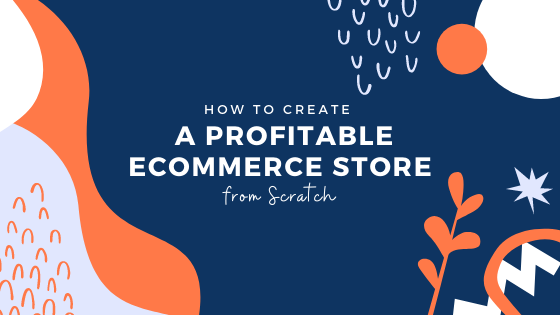Over the last few years or so, digital marketing has grown by massive amounts. It has led to the creation of brands from scratch, with plenty of well-known names establishing themselves purely because of their work on digital media.
One of the primary sources of that growth has been eCommerce. The availability for people to go online and purchase any item of their choice and have it delivered has made an eCommerce boom. Thanks to its growing popularity, brands like Amazon have seen their businesses touch multiple billions, making them one of the world’s biggest brands.
If you’re someone who wants to make money online, you need to know the tricks to create a strong eCommerce store.
What is an eCommerce Store?
In the world of digital marketing, eCommerce reigns supreme. It provides companies and brands with the platform to reach a wider audience without needing a physical store. Through digital means, brands will be able to sell their products, creating a strong connection with their audiences. eCommerce stores are present all over the world, and they see incredible growth.
The overall income from eCommerce in the U.S. in 2021 is set to touch a staggering $1 trillion. That’s because more people understand the importance of opening one, and with time can cut costs that generally come with owning a brick-and-mortar store.
Over the past decade or so, there has been a proliferation of eCommerce platforms worldwide. Choosing the right one can help brands create a long-term relationship and grow by leaps and bounds. It’s important that brands choose one that suits their needs the best. Different platforms come with their own set of advantages, and this decision can be one of the most important ones made by a company.
What are the Different eCommerce Platforms Available?
There is a whole host of eCommerce platforms available online. Here are the most prominent ones:
1. Shopify
Shopify consistently features on the list of most popular eCommerce management sites. This is because it pioneered the process and is seen as the market leader for eCommerce. Many advantages come with using Shopify apps and other features. The primary of those is its inventory system that’s super smooth and doesn’t require much control. Once you decide what products you’re selling on shopify and the audience you’re targeting, Shopify allows you to update information at your will.
Further, it allows you to sell products across a multitude of channels, including Instagram, Facebook, Amazon, and even eBay. This consistency across platforms is one of the main reasons top brands opt for Shopify, and they provide a consistent approach.
Shopify also received some of the highest scores with regards to customer satisfaction across multiple businesses.
2. Woocommerce
When it comes to user-friendliness and adaptability, few do it better than Woocommerce. There are multiple reasons to love Woocommerce, and the first one is that it allows you to start for free. Once you get a taste of its services and begin to get used to it, you can think about paying and creating a strong online presence with its services.
Another reason for its popularity is the fact that Woocommerce is easy to implement and use. With its super-smooth customization ability, it allows businesses to flourish over time. Its longevity is another factor to stick to Woocommerce, with the platform being around since 2011. It has grown from scratch and only improved with time. Also, the developers are known for being professional and reliable with their offerings for support and products.
3. BigCommerce
Another one of the popular services for eCommerce is BigCommerce. Perfect for fast-growing and large businesses, they provide services that can be easily accessed and understood.
Another significant advantage for BigCommerce is that it comes with a super range of built-in features and tools. These are perfect for supporting the growth of the store. With the powerful tools available, it becomes all the easier to keep track of the various things happening around the store, and will help in improving the overall scope of the store. Further, you can also sell via multiple channels while also managing everything from a single space.
BigCommerce allows you to sell digital, physical, and also service-based products automatically. You don’t have to install any app to allow for the same as it already comes included in the builder itself.
The platform also offers some excellent features for eCommerce management across industries.
4. Magento
One of the most popular eCommerce platforms worldwide, Magento comes with open-source technology. It also provides merchants with an opportunity to use a flexible cart system and gain access to an online store’s functionality and content. The site also offers search engine optimization, powerful marketing, and tools for catalog management.
Not only is it flexible, but it is also secure. The wide array of services for support, features, and security are fully scalable and easy to implement. Magento currently has over 260,000 merchants on board and is one of the most popular store-building platforms online.
The complete customizability adds to its benefits, and overall, it is an excellent platform for merchants who wish to implement the best in advanced technology.
5. Volusion
One of the leaders in eCommerce software solutions, Volusion provides businesses with a software platform that caters to industry needs. The eCommerce solution can be used to handle essential features such as payment processing and order management.
Volusion can help companies collect payments from customers based on sales products. With these eCommerce website stores’ creation, retailers online can easily receive instant payments and carry on their business.
6. 3DCart
3DCart has a host of benefits and comes with a 15-day free trial so that you can get used to the program and platform. It also enables you to get the store up and running before deciding to go forth and invest in the pricing plans. There are a bunch of rich SEO features and integrations for social media. This makes it easier to get your store discovered and drive traffic.
With the customized and simple mobile theme and templates, you’ll also be able to enjoy shopping across devices like phones are tablets. The software also updates the platform with the best in functionality and technology innovations so that you can maintain a competitive edge.
7. Prestashop
Prestashop is another popular eCommerce store management software that comes with a host of benefits for users. It’s super easy to install and requires you to download the necessary file from their store. Post this; you can create a functioning and responsive online store. The file size is 6 MB, so it works fast, without taking too long to download.
Prestashop is also budget-friendly and free of cost. Merchants looking for minimum investments can depend on it because there’s no need for a license to set up the store online.
The custom design is simple and convenient, without the need for technical knowledge. The user-friendly interface and simple design can be easily handled, along with the thousands of plugins available. Prestashop also comes with simple customization with which you can add and delete features.
The shop also supports multiple languages and currencies, making it easier for localization. The assistance helps them run stores around the globe. The software has stores in India, the USA, Canada, China, Germany, and Japan. The website is also capable of translating up to 45 languages.
Why Should You Use Shopify Over other eCommerce Platforms?
Shopify is great for stores that sell products or services which require minimal configuration. You can sell products with the advanced Shopify homepage section as required by your business.
Shopify also offers a simple way to quickly launch a store without worrying about development costs or worry over servers common with platforms such as Magento.
There are also no tech worries when it comes to Shopify, as it can help make the hosting faster and accommodate any spikes that come in traffic. The platform is super reliable and has 24/7 customer support for any merchant.
The app is also mobile-ready, and they’ve adapted their site to accommodate the larger number of traffic coming in. The optimized site allows merchants to create and customize the store online and help customers work with a mobile responsive cart.
Shopify is also customizable and comes with over 160 themes. Most of them are mobile responsive, and creating this unique online shop becomes simpler.
The app store has a treasure trove of functionality where you can add loyalty programs, reviews, wishlists, and receive in-depth analytics, packing slips, print labels, and shipping programs.
It’s good when you have your online store, but Shopify takes it to another level by providing a powerful SEO engine. You also gain access to advanced analytics so you can understand where your customers are coming from.
There is also a wide range of marketing tools that include product reviews, social media integration, and email marketing. You can also create gift vouchers, discount codes, and take the next level up. Shopify also provides a seamless, abandoned cart recovery experience by automatically tracking and reminding potential customers.
Finally, Shopify also comes with its payment gateway, for which you won’t have to incur transaction fees.
How to Set Up the Shopify store?
Now that you’ve understood the advantages of Shopify, you can go forth and set it up. Here’s how
Start your free trial on Shopify
With Shopify, you can start a free trial and begin to understand the initial steps that go into creating your shopify store. Once you do so, you’ll be able to understand what’s needed to integrate into the store. There are plenty of features, so you can take your time exploring it.
The free trial allows you to fully set up the store and try it before you decide to go ahead and purchase apps.
Pick a theme and customize the Shopify store
The next step is to pick yourself a theme and customize the store according to what works best for you. There are plenty of themes available, and they’re also segregated according to industry, color, and so much more. These brilliant themes can help make your store look visually stunning and offer the best functionality, so you don’t have to compromise on either.
Add the products you’d like to sell
After you’ve set up the theme, it’s time to add the products you’d like to sell in your store. Find the column and begin adding the products for customers to view. You can add extra parameters and segregate them next.
Group and categorize your products
After you’ve added the products in the store, you can go ahead and group or segregate them. Based on the parameters you’d like to add, the software allows you to categorize the products carefully. Hence, it becomes easier to create a fully-functional and optimized store that customers can visit and easily navigate.
Create necessary pages for the store
Once you’re done with the product creation, it’s time to complete the website’s look and feels. You can do that by creating the necessary pages, including the About Us, Contact page, and so much more. Shopify allows you to integrate the themes accordingly, so it becomes easier for you to manage the store right from one point.
Change your shipping settings as per your preferences
Based on how you’d like to ship your products around the world, you can set the necessary shipping settings. There are plenty of parameters available on the Shopify store, so you can accordingly do it in a way that suits your preferences.
Set up your tax settings
Shopify allows you to create tax settings with which you’ll be able to download statements and upload them for tax returns when needed. These tax settings also apply for customers shopping online, and you can adjust it based on the bracket you fall under.
Set up your payment getaway
This step is crucial because you need to know how money is coming into your system and how you’ll analyze and monitor it. You can choose from a host of payment gateways available in the store and make it easier for customers to go forth and purchase from your shop.
Test your order system
You can test the order system to know if the platform is working smoothly with your store. Once that happens, you know that you’re one step closer to going live.
Setup the domain with Shopify
Shopify then allows you to set up a domain and create a website on the internet, right from their app. You’ll be able to go live then.
Do the basic on-page SEO optimization
Optimize URL structure - Ensure the URL structure is correct, and there are no dead ends when people try to search for your site.
Optimize the Metadata - You can click on the SEO suite available with Shopify and optimize your Metadata. This can help in better visibility and get your store more traction online.
Optimize your headings - Headings give customers a taste of what’s in store (no pun intended), and you need to optimize them from time to time on the Shopify backend.
Optimize your body text with primary and secondary keywords - Help customers easily discover your store and optimize the primary and secondary keywords as needed.
Optimize your image alt tags - Image alt tags make it easier to provide more information about the product when a customer hovers over it.
Remove password protection and launch your store
You can finally remove password protection and launch your online store.
Keep tabs on all the various activities occurring and ensure that you’re constantly checking the web traffic and quality. Shopify’s features allow you to manage your store end-to-end, and with time, you’ll begin seeing the value of the investment you’ve made.
Conclusion
Keep optimizing the store and ensure that customer queries are taken care of in the right manner. After you’ve mastered Shopify, you can begin adding custom apps that simplify tasks and can be run on an automated basis, allowing you to take a backseat and focus on growth. Good luck!
Guest Post by AdNabu
AdNabu helps improve sales in Google Ads for eCommerce companies. If you are running the search, google shopping, or display campaigns in Google Ads, This software will be able to increase your sales.














